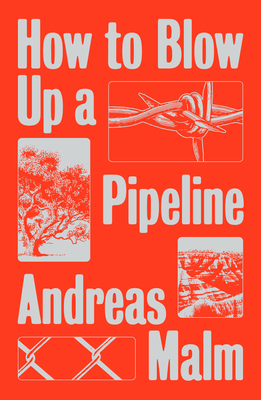Guy Montag reviewed How to Blow up a Pipeline by Andreas Malm
Instead of provocative questions, Malm offers disregard for the reader and the future
2 stars
It's not clear how this book is intended to be used. There are four main threads running through the text: 1. Malm regaling his own protest experiences deflating car tires and marching on coal mines. 2. Bemoaning how the rich are destroying the planet and condemnation for city-dwellers who own SUVs 3. References to protest movements, both violent and non-violent, around the world 4. Questions about when and how people concerned with climate change should take physical action.
I'll address each on its own.
Malm's personal experience The first, in which Malm describes his own participation in protests, is unimpressive. He's very proud of the time he and his friends snuck around a city and deflated the tires on SUVs. But it's not clear what good it did. The owners were annoyed, some of them threatened the perpetrators online, and there was a drop in SUV sales in Sweden the following year. Malm implies a connection between the protest and the sales drop, but doesn't explain why such a minor act would have a large effect.
He also participated in groups that got in the way of coal mining equipment. In these cases there's a clearer line to the impact on the companies. It makes sense why he would include the anecdotes, but the descriptions come off more as bragging than informing.
Incitement against the sinners This thread is intended to make the reader angry at the evil people responsible for causing the climate crisis. First at the super rich, whose mega yachts and private jets release huge amounts of CO2 into the atmosphere. Then also at people who perpetrate smaller yet common acts of destruction. City-dwellers with SUVs and people who take commercial flights more than necessary.
Here begins the problem. Malm neatly divides humanity into benign and evil. The super rich are evil, of course. Residents of the Global South, though they use more pollutant fuels per joule than their counterparts in the Global North, are trying to survive and it's unfair to place the burden of halting the climate crisis on their shoulders, especially as they are far less destructive on a per capita basis. So far, so good. But what about everyone else, particularly us? Malm assumes the reader is a middle-class person in North America or Europe who is aware of the climate crisis and wants things to improve. He wants us on his side and treats us as benign. Yet he also points out that most cars sold in the US are SUVs and SUV owners in general are evil. This means that a good portion of the readers are likely evil. There's no explanation for this contradiction or indications on how such a person should feel.
Overview of other protest movements Malm brings up a number of different protest movements including India, South Africa, the UK, the US and various locations in the Middle East and Central Asia. He points out that many such movements that are held up as peaceful also included at least the threat of violence. He also discusses the difference between moral non-violence (using violence is wrong) and tactical non-violence (violence will not help our cause). Again, these topics are important to the book but they aren't handled well.
He seems to care more about taking action than getting results. He praises the suffragettes, who got women the vote, and the Civil Rights Movement, which improved conditions for Blacks in America, but offers similar admiration for the 2011 Egyptian revolution, which brought down the authoritarian Mubarak but led to the current authoritarian rule of el-Sisi. In Iran he writes in favor of both the revolution against the Shah and later opposition to the Islamic Republic, glossing over the fact that the 1979 revolutionaries were the ones who brought in the current theocracy. He also praises the Houthi for their 2019 drone attack on Aramco's oil facilities. The US responded by sending thousands of troops to Saudi Arabia and Iran reported that one of its civilian ships was hit by rockets, presumably fired by either Saudi Arabia or the US.
This section made me question the rest of the book. I don't have a deep understanding of the science behind climate change, but I do know the modern history of the Levant. Malm's take on it is very distorted. If he got the one topic I know well so wrong, even if it is a relatively small part of the book, how can I rely on him for anything else?
What should the climate movement do? This should have been the main thrust of the book. He needed to address questions including: - Should climate activists, whom Malm describes as extremely adverse to violence, employ violent tactics? - If so, should the violence be limited to property destruction or also violence against people? - Should they take up violence now? - If not, at what point should they? - How should climate activists handle the blowback following their violence?
Malm touches on each of these except the last, but only vaguely. It comes across as trying to avoid saying what he actually thinks. All I know from the book is that if some individuals or small groups want to take up violence now or at a later point, they probably should avoid harming people. There should be a clear division between the violent minority and the non-violent majority, but the two sides should also coordination their actions.
My biggest problem with the book is that How to Blow Up a Pipeline doesn't care about the potential fallout from its proposed violence. What happens if climate activists do blow up a pipeline, leading to oil prices increasing, and poor people die because they can't afford to heat their homes?
Returning to the implied reader, it seems that Malm also doesn't expect to have minorities in his audience. He holds up Jessica Reznicek and Ruby Montoya, two women who burned machinery in protests against the Dakota Access Pipeline, as models of environmental sabotage. The pair turned themselves in and one was sentenced to eight years in prison. Writing three years after George Floyd was murdered, Malm implies that this is how all earnest climate activists can expect to be treated.
On a larger scale, how will governments and massive corporations respond to attacks on their infrastructure? How should activists handle it when they do? Malm has nothing to say.

